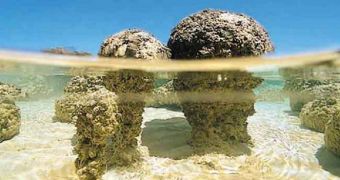Finding out how life appeared on our planet has been one of the main goals in Science for hundreds of years, but the answer has proven elusive and difficult to find out. This knowledge could help us determine the conditions that need to be met by an exoplanet or exomoon, for example, so that they can be considered viable candidates for supporting even basic lifeforms as well. Now, new studies seem to suggest that scientists don't have to look very far or deep into the Earth's history, in order to determine how the first organisms appeared. A growing body of pieces of evidence suggests that shallow waters might have been ground zero.
Until recently, the main theory of how life appeared in the oceans held that hydrothermal vents were the main engines of evolution. These features can be found at the bottom of the sea, at depths of about 2,100 meters (1.3 miles), and they were discovered for the first time in 1977. They are conduits through which gases emanate from the planet's mantle, and they can trigger temperatures in excess of 300 degrees Celsius in their immediate vicinity. These high values made some experts reject the hypothesis that life originated around these structures.
Critics argue that organic molecules, which are a basic requirement for life, are unstable at such high temperatures, and therefore can't organize in the complex patterns needed to create even the most basic lifeforms. Shallower hydrothermal vents, on the other hand, are another matter. Located at depths of about 200 meters (656 feet), they may have very well provided the necessary conditions that molecules needed to arrange. Details of the new hypothesis appear in the November issue of the prestigious scientific journal Astrobiology, LiveScience reports.
“Shallow water hydrothermal vents have been dismissed. There are plenty of shallow hydrothermal thermal vents but they have been studied less,” Marcelo Guzman, the lead author of the new journal entry, explains. He is also a Harvard University Department of Earth and Planetary Sciences (DEPS) School of Engineering and Applied Sciences origins of life postdoctoral fellow. He explains that the depth is shallow enough to allow for sunlight to penetrate to the level of the vents. Light, as it's widely known, is an important catalyst in chemical reactions, which underlie any living creature.
In addition, the expert says, the temperature in shallower vents is between ten and 96 degrees Celsius, meaning that the regions are more suited to allow for life to form than their deep-sea counterparts. “Shallow hydrothermal water systems are more temperate,” Guzman adds. “We're talking about prebiotic metabolism. Maybe metabolites in the environment allowed the first cells to have the chemistry they needed to run. Maybe in the first cell, a mineral catalyzed certain reactions,” he says.
“The inevitability of certain compounds appearing again and again kind of links to what people have been thinking about – the core metabolism as being the essential starting point. It’s a set of experiments that other people aren’t doing. It highlights how much work needs to be done. There are many different environments where one can simulate experiments, but there's a lot more to the story than just that. On has to link reliable chemistry with geochemical reality,” Carnegie Institution of Washington senior research scientist George Cody concludes.

 14 DAY TRIAL //
14 DAY TRIAL //